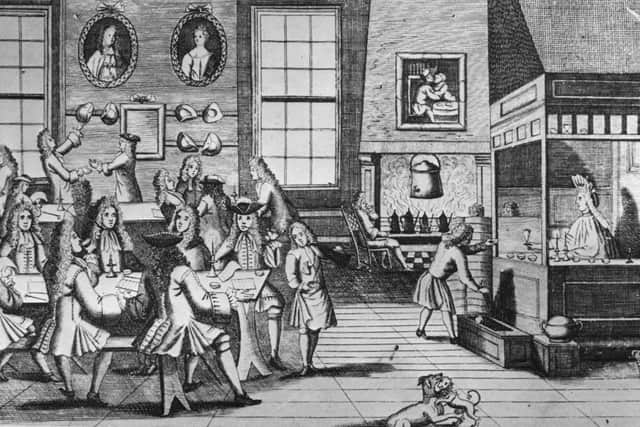How coffee helped to build modern Scotland (after playing a part in its ruination) – Susan Morrison
On a chilly February day in 1696, three aristocratic women sailed along Edinburgh’s High Street, ready to sign up to invest in the bold new venture that we now call Darien. Well, we all know how that panned out. But what isn’t so well known is where those first books of investment were kept and signed.
A bank? A lawyers’ office? The home of a potential wealthy backer? No, our three investing angels were huckled into Mrs Purdie’s Coffee Shop by the Old Mercat Cross. We’re talking ladies of quality here, so you can bet your bottom dollar that Anne, Duchess of Hamilton, Margaret, Countess of Rothesse, and Lady Margaret Hope of Hopetoun demanded three strong Americanos to sit-in before pen was put to paper. No doubt they got served sharpish, and no one misspelt their name on a take-out cup.
Advertisement
Hide AdAdvertisement
Hide AdIt seems odd to our eyes that these high-stake investment dealings were being carried out in a coffee shop. It's like seeing a biotech company launching in a petrol station Starbucks. Well, Darien was a national, almost democratic money-raising scheme. A sort of giant crowdfunder. Anyone could invest. It makes sense that the books should be first opened in a place where folks of all airts and pairts could meet. The coffee shop.
When John Row opened the first coffee house in Edinburgh in 1673, near the old Parliament House, it was a game changer. Coffee became the craze and the chattering classes had to have it, which is pretty remarkable when you consider just how coffee was made back in the late 17th century. Coffee snobs, look away now.
It was frequently brewed in great vats. Some establishments favoured letting it cool, then reheating it. Some just left it to bubble away, a practice familiar to anyone who ordered coffee on a CalMac ferry in the 1960s. It was thought to inspire, but not intoxicate, and thus lead to reasoned debate and fewer ale-house brawls. Well, that was the theory, but given that Mr Row’s coffee shop was closed four years after it opened because of a punch-up, I guess they hadn’t spotted that stewed caffeine can do a lot of damage in a nervy situation.
Scotland loved its coffee and its coffee shops. As in London, various shops took on their own personalities. The traders in tea, silk and other exotic goods could be found discussing business in the Royal Exchange Coffee House in Edinburgh. Down in Leith, sea captains touting for their next command could mooch into Gibb’s near The Shore, looking for ship owners with a vacancy.
Glasgow’s Tobacco Lords, newly rich and happy to spend, hung out in luxurious coffee houses like The Tontine. Lawyers might hang out in Balfours near the Old Parliament, handy for the courts. Everyone was caffeined up to the eyeballs.


These shops became hubs of the Enlightenment, buzzing with not just thinkers, writers, and philosophers, but also clerics, carters and ordinary working men. As long as you had the price of a cup of Joe, you were welcome, and so were your opinions. Newspapers, broadsheets and pamphlets were read, argued over and debated.
One 18th-century traveller to Edinburgh describes Scotland as the “Disputatious Nation”. It was very much two Scotsmen, three opinions. Out of this bubbling brew of coffee and babble grew notions of democracy, freedom and at least one bank. Scotland was partly shaped by its coffee houses.
Despite all that reasoned, non-bevvied debate, actually running a coffee house wasn’t an easy gig. Adam Smith could corner you to drone out the whole of the Wealth of Nations, not an easy listen, I imagine. Then there’s the supply line from Mocha in Yemen to Leith. It was fraught with danger. A lot could go wrong. Ships could be lost, cargo spoiled or seized by pirates. The duty on coffee was high. Coffee shops were licensed. The expenses were pretty steep. A tidy sum for a small businessman to shell out.
Advertisement
Hide AdAdvertisement
Hide AdYou could cut costs. Water the product down, a sort of early accidental partial decaffeination, by cutting it with peas, sawdust or sand. At least it was organic. Or use the grounds over and over again. Others took extreme measures to make the books balance. They might know a bloke who could get good coffee ashore on a remote beach round Eyemouth way, avoiding the exciseman and the duty.
Some proprietors turned to self-publicity, and in 1760s’ Edinburgh, none was quite so high-profile as Peter Williamson or, as his friends knew him, Indian Pete. He had quite the tale to tell. As a child in Aberdeen, Peter had been kidnapped and sold into indentured slavery in the American plantations. He eventually did well for himself, only to be captured by Cherokees and forced into a life of terrible hardship. He escaped, but luck was not with our boy. The French got him next. It's a long story, which you can read in his book, French and Indian Cruelty. Finally, he winds up in Edinburgh, running Indian Peter's American Coffee House.
Whenever the custom dried up, Pete would don the Native American war outfit he’d had made and run up and down the High Street screaming bloodcurdling battle cries and, presumably, telling everyone the special offers of the day. I'm not sure it’s a practical idea today in Edinburgh, especially during the Fringe, but it must have worked. The shop was there for decades. Even Benjamin Franklin dropped by.
The next time you order up a full-fat latte or a skinny hazelnut macchiato, you are following in the caffeine-fuelled footsteps of the people who made Scotland as it is today. Listen out. You might hear the distant howl of a Native American war-cry.
Comments
Want to join the conversation? Please or to comment on this article.
